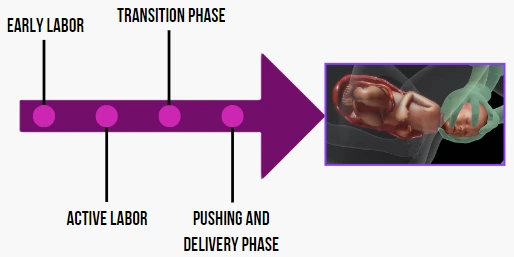What is Labour Pain?
As expectant mothers eagerly await the arrival of their little ones, one of the significant milestones they experience is the onset of labour pain. It can be an overwhelming and exciting time, filled with mixed emotions and questions. Labour pain is a natural part of childbirth, but with the right tools and support, gestating women can navigate it successfully. By embracing mindfulness, utilizing relaxation techniques, exploring movement and positioning, and being aware of medical interventions, mothers-to-be can approach labour with confidence and a sense of empowerment.
Concept of Labour: Understanding the Journey of Childbirth
Labour is a natural and complex phenomenon by which a woman’s body undergoes contractions to bring her baby into the world. It is a remarkable journey that varies in duration and intensity, ultimately culminating in the beautiful moment of childbirth. The mother’s expedition through labour unfolds in three distinctive stages, encompassing a myriad of obstacles and triumphs (Explore previous blog – Stages and factors which affect labour pain).

“Birth: The Miracle Unveiled through Labour”
Initiating the Journey: Onset of Labour in Pregnancy
When does labour start in pregnancy?
Labour, the process by which a baby is born, typically begins in the later stages of pregnancy, specifically during the third trimester. While the average duration of pregnancy is around 40 weeks, labour can start as early as the 37th week and as late as the 42nd week of gestation. Any instance of labour that takes place prior to reaching 37 weeks of pregnancy is categorized as premature or preterm labour.
Just as each woman’s pregnancy journey is unique, the onset of labour, the indications of labour, and the duration of the labour process exhibit individual variations, both among women and even within different pregnancies for the same woman.
Here are some key points regarding the onset of labour:
Full-term pregnancy: A full-term pregnancy is considered to be between 39 weeks and 40 weeks + 6 days. Most women go into labour naturally within this timeframe.
The onset of labour: Labour typically begins with the onset of regular and progressively stronger contractions. These contractions cause the cervix to dilate further and efface. The contractions become more intense and closer together over time. Signs of impending labour: Prior to the onset of labour, some common signs and symptoms may occur, although they can differ among individuals. These may include:
- Lightening: The baby’s head descends into the pelvis, relieving pressure on the diaphragm and causing the belly to appear lower.
- Braxton Hicks contractions: Irregular, mild contractions that may be felt as a tightening sensation in the abdomen.
- Cervical changes: The cervix may start to soften, thin out (efface), and dilate (open up) in preparation for labour.
- Increased vaginal discharge: This may occur as the body prepares for birth.
- Bloody show: The release of a small amount of blood-tinged mucus from the cervix.
- Rupture of membranes: The amniotic sac may break, leading to the release of amniotic fluid (commonly known as water breaking).
The onset of labour: Labour typically begins with the onset of regular and progressively stronger contractions. These contractions cause the cervix to dilate further and efface. The contractions become more intense and closer together over time.
“From Anticipation to Action: Cherish the Onset of Labour”
The Journey of Labour Pain
The timeline for the onset of labour pain in pregnancy can vary from woman to woman. However, here is a general timeline that outlines the typical progression of labour pain:

Stages of Labour
1. Early Labour:
- Duration: Can range from a few hours to a couple of days.
- Contractions: Contractions may start as irregular and mild, occurring every 10-20 minutes and lasting around 30-45 seconds. They gradually become more regular.
- Pain: Initially, there may be a sense of excitement or anticipation. As labour progresses, mild to moderate discomfort or aching sensations develop in the lower back or abdomen, similar to menstrual cramps.
- Cervix: Begins to efface (thin out) and dilate (open up) up to around 3-4 centimetres. Some women may experience a “bloody show,” which is the release of the mucus plug that seals the cervix.
2. Active Labour:
- Duration: Typically lasts around 4-6 hours, but it can vary.
- Contractions: Contractions become stronger, more intense, and more frequent. They occur every 3-5 minutes and last around 45-60 seconds.
- Pain: The intensity of pain increases as contractions become more powerful and longer-lasting. The pain may radiate from the lower back to the abdomen. Breathing techniques and relaxation exercises have become important for coping with discomfort.
- Cervix: Continues to dilate, progressing from around 4-7 centimetres. The cervix may dilate more rapidly during this stage.
3. Transition phase:
- Duration: Usually the shortest but most intense stage, lasting around 30 minutes to 2 hours.
- Contractions: Contractions reach their peak intensity during this phase. They occur every 2-3 minutes and last 60-90 seconds.
- Pain: Intense pressure and pain are experienced. Women may feel a strong urge to push or bear down. The discomfort may be accompanied by shaking, sweating, or nausea.
- Cervix: Fully dilated at 10 centimetres, marking the end of the active phase of labour.
4. Pushing and Delivery phase:
- Duration: Can range from a few minutes to a couple of hours.
- Contractions: Contractions may become less intense or subside temporarily. The focus shifts to actively pushing with each contraction.
- Pain: Intense pressure and a stretching sensation are felt as the baby’s head descends through the birth canal. The “ring of fire” sensation may occur as the baby’s head crowns.
- Cervix: Fully dilated, allowing for the delivery of the baby’s head. Afterwards, the rest of the baby’s body is born.
ELLE TENS: Empowering Labour Induction with Technology and Comfort

ELLE TENS machines are specifically engineered for childbirth, often including a handheld unit with adjustable controls for the electrical impulses’ intensity and frequency. The electrode pads are typically placed on the lower back, targeting the area of pain or discomfort.
When used during labour, the ELLE TENS machine activates the nerves in the lower back, potentially blocking pain signals from reaching the brain, and producing pain-killing hormones (endorphins). This natural form of pain relief can facilitate relaxation during contractions. Moreover, ELLE TENS primarily emphasizes inducing labour and shortening its duration. Many women find TENS machines, especially those from the ELLE TENS brand, helpful in managing their labour pain.
“Honoring Labour’s Success: The Unforgettable Voyage of Birth Pain”





